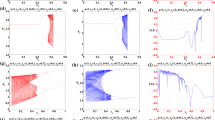Abstract
The economy is never in equilibrium despite the fact that most of the studies is focused on equilibrium economy. The nonequilibrium economy shows abrupt changes such as bifurcation and catastrophe from time to time in the examples of financial market breakdown and economic crisis in recent years. In this study, we explore the physical origin of the bifurcation and catastrophe of the non-equilibrium economic systems based on our landscape and flux theory. From the underlying nonlinear supply-demand dynamics, both the bistability and limit cycle oscillations can appear. The transformation or bifurcation from bi-stability to limit cycle oscillation or vice versa can occur upon changing the slope of demand curve. The transformation of bifurcation of the monostable state of monopoly or competition to either the bistability of monopoly and competition or coherent limit cycle oscillation between monopoly and competition can appear upon parallel shifting the demand curve. We show that the average flux of the driving force can provide a dynamical origin for the bifurcation/catastrophe of the nonequilibrium economy while the dissipation cost characterized by the entropy production rate can provide a thermodynamic origin for the bifurcation/catastrophe of the nonequilibrium economy. The average flux and dissipation cost can then be used as indicators of critical points for the emergence of bifurcation and catastrophe. These quantitative measures may be used to predict crisis and catastrophe in the non-equilibrium economic system.
Graphic abstract







Similar content being viewed by others
Data Availability Statement
This manuscript has no associated data or the data will not be deposited. [Authors’ comment: This is a theoretical study and no experimental data. All data from the equations and algorithms during this study are shown in all the figures of this published article.]
References
L. Walras, Elements of Economic Politique Pure, 1st Edition, Lausanne:F. Rouge; English translation, William Jaffe, 1954, Elements of Pure Economics, London: Allen and Unwin (1874)
A. Marshall, Principles of Economics (MacMillan, London, 1890)
J. Robinson, The Economics of Imperfect Competition (Macmillan, London, 1933)
G. Bonanno, Monopoly Equilbria and Catastrophe Theory. Aust. Econ. Pap. 26, 197–215 (1987)
V. Pareto, Manual of Economie Politique (Girard et Briere, Paris, 1909)
J.B. Rosser, From Catastrophe to Chaos: A General Theory of Economic Discontinuities: Mathematics, Microeconomics, Macroeconomics, and Finance, vol. 1, 2nd edn. (Kluwer Academic Publishers, Boston, 2000)
J.M. Keynes, The General Theory of Employment, Interest and Money (Macmillan, London, 1936)
R.M. Goodwin, A Growth Cycle, in Socialism, Capitalism and Economic Growth. ed. by C.H. Feinstein (Cambridge University Press, Cambridge, 1967)
K. Marx, Capital I: The Process of Production of Capital (International Publishers, New York, 1998)
I. Fisher, The debt-deflation theory of great depressions. Econometrica 1, 337C55 (1933)
S. Keen, Finance and economic breakdown: modeling Minsky’s Financial Instability Hypothesis. J. Post Keynesian Econ. 17(4), 607C35 (1995)
S. Keen, Debunking Economics: The Naked Emperor of the Social Sciences. Pluto Press, Australia (2001)
K. Zhang, J. Wang, Landscape and flux theory of non-equilibrium open economy. Phys. A 482, 189C208 (2017)
M. Beckmann, H. Ryder, Simultaneous price and quantity adjustment in a single market. Econometrica 37, 470–484 (1969)
A. Mas-Colell, The price equilibrium existence problem in topological vector lattices. Econometrica 54(5), 1039–1053 (1986)
N.V.Tu. Pierre, Dynamical Systems: An Introduction with Applications in Economics and Biology. Springer, New York (1994)
J. Wang, L. Xu, E. Wang, Potential landscape and flux framework of nonequilibrium networks: robustness, dissipation, and coherence of biochemical oscillations. Proc. Natl. Acad. Sci. USA 105, 12271–12276 (2008)
J. Wang, Landscape and flux theory of nonequilibrium dynamical systems with application to biology. Adv. Phys. 64(1), 1–137 (2015)
H.D. Feng, Potential and flux decomposition for dynamical systems and non-equilibrium thermodynamics: curvature, gauge field, and generalized fluctuation-dissipation theorem. J. Chem. Phys. 135(23), 234511 (2011)
J. Wang, X. Fang, K. Kruse, T. Lu, Nonequilibrium physics in biology. Rev. Modern Phys. 91, 045004 (2019)
S. Osher, J.A. Sethian, Fronts propagating with curvature dependent speed. Algorithms based on Hamilton–Jacobi formulations. J. Comput. Phys. 79, 12C49 (1988)
I.M. Mitchell, The flexible, extensible and efficient toolbox of level set methods. J. Sci. Comput. 35, 300C329 (2008)
H.K. Khalil, Nonlinear Systems (Prentice Hall, Upper Saddle River, 1996)
A.E.R. Woodcock, M. Davis, Catastrophe Theory (E.P.Dutton, New York, 1978)
Acknowledgements
K.Z. and E.W. thank the supports from Ministry of Science and Technology of China Grants 2016YFA0203200 and National Nature Science Foundation of China Grants No. 21721003.
Author information
Authors and Affiliations
Contributions
JW and EW designed the project; KZ performed research; JW contributed new analytic tools; KZ and JW analyzed data; and all the authors wrote and reviewed the manuscript.
Corresponding author
Rights and permissions
About this article
Cite this article
Zhang, K., Wang, E. & Wang, J. Searching for the physical origin of bifurcations in non-equilibrium economy. Eur. Phys. J. B 94, 213 (2021). https://doi.org/10.1140/epjb/s10051-021-00218-4
Received:
Accepted:
Published:
DOI: https://doi.org/10.1140/epjb/s10051-021-00218-4




